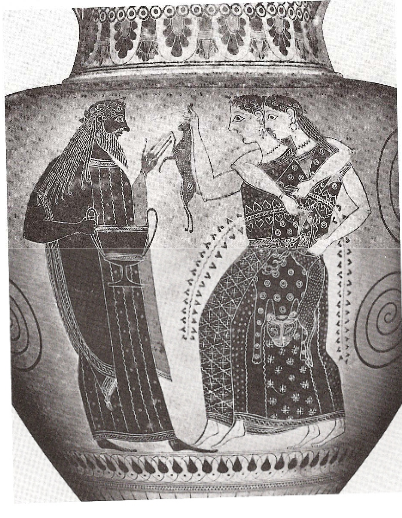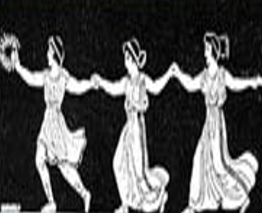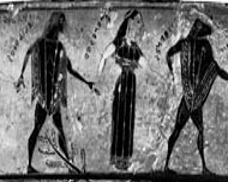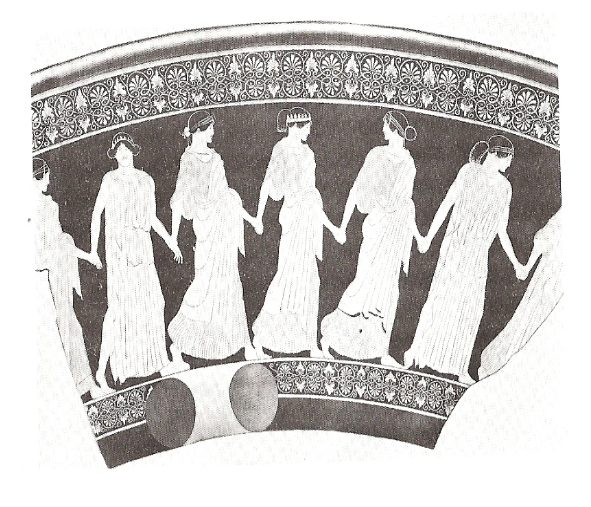GREEK ANTIQUITY

Dance in Ancient Greece
With the Greeks, dancing certainly was primarily part of a religious rite; with music it formed the lyric art. The term, however, with them included all those actions of the body and limbs, and all expressions and actions of the features and head which suggest ideas; marching, acrobatic performances, and mimetic action.
According to the legendary accounts of the Greeks, the gods taught the dance to the mortals so that they “honor them and rejoice”.
According to the historians, the Greeks attributed dancing to their deities: Homer makes Apollo orchestes, or the dancer; Terpsichore was the muse who protected dance.
Their dances may be divided into sections somewhat thus: (1) those of a religious species, (2) those of a gymnastic nature, (3) those of a mimetic character, (4) those of the theatre, such as the chorus, (5) those partly social, partly religious dances, such as the hymeneal, and (6) chamber dances.
Grown up men and women did not dance together, but the youth of both sexes joined .
The important religious and other dances were not generally composed of professionals. Sofocles danced after Salamis. There were dancers of all grades, from the distinguished to the moderate.
Suggested Readings
Historic Illustrations of Dancing by an ANTIQUARY Chapter II
The role of dance in religious actions in antiquity by PAPAÏWANNOU Christina (in Greek)
Dance in Ancient Greece by Evaggelos Albanidis (in Greek)
The principal Religious Dances
Apollo and the Muses protected dance. Many primitive dances concerned the cult of Cybele. Dances in honour of Venus were common, she was the patroness of proper and decent dancing; on the contrary, those in honour of Dionysus or Bacchus degenerated into revelry and obscenity




Aloenes
According to some authorities, it was one of the most primitive of Phrygian origin danced to the Phrygian flute by the priests of Cybele in honour of her daughter Ceres.
Anthema, Bookolos, Epicredros
Dances celebrated in the cult of Cybele among others. Every locality had one of its own. Some were rustic for labourers, others of shepherds, etc.
Hyporchema
It is one of the early greek dances dedicated to Apollo. It was a cross between dancing and pantomime and was used in theater.
Epilenios
Dedicated to Dionysus and danced when the grapes were pressed. It imitated the gathering and pressing.
Anteisterios
Dedicated to Dionysus and danced when the wine was vatted.
Bahilicos
Dedicated to Dionysus and danced to the sistrus, cymbals, and tambour; often degenerated into orgies.
Panathenea
Originally from Delos, is said to have been originated by Theseus in memory of his escape from the labyrinth of Crete . It was a hand-in-hand dance alternately of males and females. The dance was led by the representative of Theseus playing the lyre.
Coribantum
It was of Phrygian origin and of a mixed religious, military, and mimetic character; the performers were armed, and bounded about, springing and clashing their arms and shields to imitate the Corybantes endeavouring to stifle the cries of the infant Zeus, in Crete.
Funeral dances,
In Athens, slow, solemn dances in which the priests took part. The performers wore long white robes, and carried cypress slips in their hands.
Hymeneal dances
Were lively and joyous during wedding ceremonies. The dancers being crowned with flowers and were designed to imitate the combats of the Centaurs and Lapithæ.
Geranos:
This popular dance uses snake-like movements. It recreates the story of Theseus escaping the labyrinth after killing the Minotaur.
Paian
It was originally danced in honor of Apollo to stop diseases and later in honor of other gods, such as Asclepius, Pan, Athena and others. It was used as a begging ritual in times of epidemics or other afflictions, as a prayer before battles or other important missions, as a triumph in general or an expression of joy.
Partheneia
Dance of Doric cities by virgins in honor of Hera, Apollo, Artemis, but also various deities or mythical heroes. Simple and charming danced by girls full of joy.
Top Image : Apollo and the Muses
Credit : Coll. Jonas/KHARBINE-TAPABOR.
